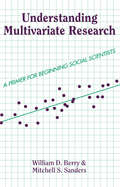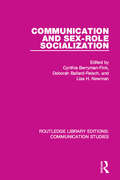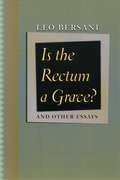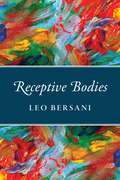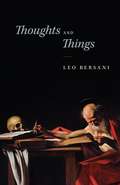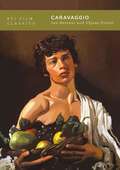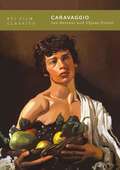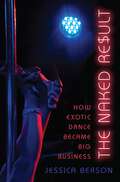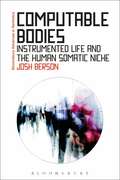- Table View
- List View
Understanding Multivariate Research: A Primer For Beginning Social Scientists
by William BerryAlthough nearly all major social science departments offer graduate students training in quantitative methods, the typical sequencing of topics generally delays training in regression analysis and other multivariate techniques until a student's second year. William Berry and Mitchell Sanders's Understanding Multivariate Research fills this gap with a concise introduction to regression analysis and other multivariate techniques. Their book is designed to give new graduate students a grasp of multivariate analysis sufficient to understand the basic elements of research relying on such analysis that they must read prior to their formal training in quantitative methods. Berry and Sanders effectively cover the techniques seen most commonly in social science journals--regression (including nonlinear and interactive models), logit, probit, and causal models/path analysis. The authors draw on illustrations from across the social sciences, including political science, sociology, marketing and higher education. All topics are developed without relying on the mathematical language of probability theory and statistical inference. Readers are assumed to have no background in descriptive or inferential statistics, and this makes the book highly accessible to students with no prior graduate course work.
Understanding Multivariate Research: A Primer For Beginning Social Scientists
by William BerryAlthough nearly all major social science departments offer graduate students training in quantitative methods, the typical sequencing of topics generally delays training in regression analysis and other multivariate techniques until a student's second year. William Berry and Mitchell Sanders's Understanding Multivariate Research fills this gap with a concise introduction to regression analysis and other multivariate techniques. Their book is designed to give new graduate students a grasp of multivariate analysis sufficient to understand the basic elements of research relying on such analysis that they must read prior to their formal training in quantitative methods. Berry and Sanders effectively cover the techniques seen most commonly in social science journals--regression (including nonlinear and interactive models), logit, probit, and causal models/path analysis. The authors draw on illustrations from across the social sciences, including political science, sociology, marketing and higher education. All topics are developed without relying on the mathematical language of probability theory and statistical inference. Readers are assumed to have no background in descriptive or inferential statistics, and this makes the book highly accessible to students with no prior graduate course work.
Serial Killers at the Movies
by Christopher Berry-DeeThe depraved crimes of both real and imagined serial killers and mass murderers have long transfixed us in newspapers and books, but perhaps nowhere more so than on the big screen. Films such as Silence of the Lambs, Psycho and Henry: Portrait of a Serial Killer have not only reached huge audiences but also allowed us into the minds of society’s most disturbed individuals.Bestselling author, Christopher Berry-Dee, talks to the serial killers whose wicked stories have most thrilled and fascinated us at the movies and, through far-ranging and disturbing interviews, he tells the stories of the mass murderers who provided the inspiration for some of cinema’s most shocking films.Serial Killers at the Movies takes the reader on an uncomfortable and truly dark journey into a lurid world of murder and deviancy.
Communication and Sex-role Socialization (Routledge Library Editions: Communication Studies)
by Cynthia Berryman-Fink Deborah Ballard-Reisch Lisa H. NewmanOriginally published in 1993. The essays in this book collectively seek to illuminate the role of communication and sex-role socialization throughout the life cycle. Section 1 addresses some important issues and behaviours that have an impact on the beginnings of the socialization process. Section 2 covers socialization later on in relationships, the workplace and the political arena while section 3 looks at manifestations of socialization through communication strategies and skills. Finally section 4 addresses ways to alter socialization through instructional practices in higher education. The approach to studying sex-role socialization varies by perspective and methodology and conclusions are interpreted in diverse ways but the results have been very similar and the research in this volume shows that the socialization of males and females continues to reinforce male dominance despite women’s advancement toward equal status in society. This work is of interest in the fields of sociology, psychology, anthropology and women’s studies as well as communication.
Communication and Sex-role Socialization (Routledge Library Editions: Communication Studies)
by Cynthia Berryman-Fink Deborah Ballard-Reisch Lisa H. NewmanOriginally published in 1993. The essays in this book collectively seek to illuminate the role of communication and sex-role socialization throughout the life cycle. Section 1 addresses some important issues and behaviours that have an impact on the beginnings of the socialization process. Section 2 covers socialization later on in relationships, the workplace and the political arena while section 3 looks at manifestations of socialization through communication strategies and skills. Finally section 4 addresses ways to alter socialization through instructional practices in higher education. The approach to studying sex-role socialization varies by perspective and methodology and conclusions are interpreted in diverse ways but the results have been very similar and the research in this volume shows that the socialization of males and females continues to reinforce male dominance despite women’s advancement toward equal status in society. This work is of interest in the fields of sociology, psychology, anthropology and women’s studies as well as communication.
Is the Rectum a Grave?: and Other Essays
by Leo BersaniOver the course of a distinguished career, critic Leo Bersani has tackled a range of issues in his writing, and this collection gathers together some of his finest work. Beginning with one of the foundations of queer theory—his famous meditation on how sex leads to a shattering of the self, “Is the Rectum a Grave?”—this volume charts the inspired connections Bersani has made between sexuality, psychoanalysis, and aesthetics. Over the course of these essays, Bersani grapples with thinkers ranging from Plato to Descartes to Georg Simmel. Foucault and Freud recur as key figures, and although Foucault rejected psychoanalysis, Bersani contends that by considering his ideas alongside Freud’s, one gains a clearer understanding of human identity and how we relate to one another. For Bersani, art represents a crucial guide for conceiving new ways of connecting to the world, and so, in many of these essays, he stresses the importance of aesthetics, analyzing works by Genet, Caravaggio, Proust, Almodóvar, and Godard. Documenting over two decades in the life of one of the best minds working in the humanities today, Is the Rectum a Grave? and Other Essays is a unique opportunity to explore the fruitful career of a formidable intellect.
Is the Rectum a Grave?: and Other Essays
by Leo BersaniOver the course of a distinguished career, critic Leo Bersani has tackled a range of issues in his writing, and this collection gathers together some of his finest work. Beginning with one of the foundations of queer theory—his famous meditation on how sex leads to a shattering of the self, “Is the Rectum a Grave?”—this volume charts the inspired connections Bersani has made between sexuality, psychoanalysis, and aesthetics. Over the course of these essays, Bersani grapples with thinkers ranging from Plato to Descartes to Georg Simmel. Foucault and Freud recur as key figures, and although Foucault rejected psychoanalysis, Bersani contends that by considering his ideas alongside Freud’s, one gains a clearer understanding of human identity and how we relate to one another. For Bersani, art represents a crucial guide for conceiving new ways of connecting to the world, and so, in many of these essays, he stresses the importance of aesthetics, analyzing works by Genet, Caravaggio, Proust, Almodóvar, and Godard. Documenting over two decades in the life of one of the best minds working in the humanities today, Is the Rectum a Grave? and Other Essays is a unique opportunity to explore the fruitful career of a formidable intellect.
Is the Rectum a Grave?: and Other Essays
by Leo BersaniOver the course of a distinguished career, critic Leo Bersani has tackled a range of issues in his writing, and this collection gathers together some of his finest work. Beginning with one of the foundations of queer theory—his famous meditation on how sex leads to a shattering of the self, “Is the Rectum a Grave?”—this volume charts the inspired connections Bersani has made between sexuality, psychoanalysis, and aesthetics. Over the course of these essays, Bersani grapples with thinkers ranging from Plato to Descartes to Georg Simmel. Foucault and Freud recur as key figures, and although Foucault rejected psychoanalysis, Bersani contends that by considering his ideas alongside Freud’s, one gains a clearer understanding of human identity and how we relate to one another. For Bersani, art represents a crucial guide for conceiving new ways of connecting to the world, and so, in many of these essays, he stresses the importance of aesthetics, analyzing works by Genet, Caravaggio, Proust, Almodóvar, and Godard. Documenting over two decades in the life of one of the best minds working in the humanities today, Is the Rectum a Grave? and Other Essays is a unique opportunity to explore the fruitful career of a formidable intellect.
Receptive Bodies
by Leo BersaniLeo Bersani, known for his provocative interrogations of psychoanalysis, sexuality, and the human body, centers his latest book on a surprisingly simple image: a newborn baby simultaneously crying out and drawing its first breath. These twin ideas—absorption and expulsion, the intake of physical and emotional nourishment and the exhalation of breath—form the backbone of Receptive Bodies, a thoughtful new essay collection. These titular bodies range from fetuses in utero to fully eroticized adults, all the way to celestial giants floating in space. Bersani illustrates his exploration of the body’s capacities to receive and resist what is ostensibly alien using a typically eclectic set of sources, from literary icons like Marquis de Sade to cinematic provocateurs such as Bruno Dumont and Lars von Trier. This sharp and wide-ranging book will excite scholars of Freud, Foucault, and film studies, or anyone who has ever stopped to ponder the give and take of human corporeality.
Receptive Bodies
by Leo BersaniLeo Bersani, known for his provocative interrogations of psychoanalysis, sexuality, and the human body, centers his latest book on a surprisingly simple image: a newborn baby simultaneously crying out and drawing its first breath. These twin ideas—absorption and expulsion, the intake of physical and emotional nourishment and the exhalation of breath—form the backbone of Receptive Bodies, a thoughtful new essay collection. These titular bodies range from fetuses in utero to fully eroticized adults, all the way to celestial giants floating in space. Bersani illustrates his exploration of the body’s capacities to receive and resist what is ostensibly alien using a typically eclectic set of sources, from literary icons like Marquis de Sade to cinematic provocateurs such as Bruno Dumont and Lars von Trier. This sharp and wide-ranging book will excite scholars of Freud, Foucault, and film studies, or anyone who has ever stopped to ponder the give and take of human corporeality.
Receptive Bodies
by Leo BersaniLeo Bersani, known for his provocative interrogations of psychoanalysis, sexuality, and the human body, centers his latest book on a surprisingly simple image: a newborn baby simultaneously crying out and drawing its first breath. These twin ideas—absorption and expulsion, the intake of physical and emotional nourishment and the exhalation of breath—form the backbone of Receptive Bodies, a thoughtful new essay collection. These titular bodies range from fetuses in utero to fully eroticized adults, all the way to celestial giants floating in space. Bersani illustrates his exploration of the body’s capacities to receive and resist what is ostensibly alien using a typically eclectic set of sources, from literary icons like Marquis de Sade to cinematic provocateurs such as Bruno Dumont and Lars von Trier. This sharp and wide-ranging book will excite scholars of Freud, Foucault, and film studies, or anyone who has ever stopped to ponder the give and take of human corporeality.
Receptive Bodies
by Leo BersaniLeo Bersani, known for his provocative interrogations of psychoanalysis, sexuality, and the human body, centers his latest book on a surprisingly simple image: a newborn baby simultaneously crying out and drawing its first breath. These twin ideas—absorption and expulsion, the intake of physical and emotional nourishment and the exhalation of breath—form the backbone of Receptive Bodies, a thoughtful new essay collection. These titular bodies range from fetuses in utero to fully eroticized adults, all the way to celestial giants floating in space. Bersani illustrates his exploration of the body’s capacities to receive and resist what is ostensibly alien using a typically eclectic set of sources, from literary icons like Marquis de Sade to cinematic provocateurs such as Bruno Dumont and Lars von Trier. This sharp and wide-ranging book will excite scholars of Freud, Foucault, and film studies, or anyone who has ever stopped to ponder the give and take of human corporeality.
Receptive Bodies
by Leo BersaniLeo Bersani, known for his provocative interrogations of psychoanalysis, sexuality, and the human body, centers his latest book on a surprisingly simple image: a newborn baby simultaneously crying out and drawing its first breath. These twin ideas—absorption and expulsion, the intake of physical and emotional nourishment and the exhalation of breath—form the backbone of Receptive Bodies, a thoughtful new essay collection. These titular bodies range from fetuses in utero to fully eroticized adults, all the way to celestial giants floating in space. Bersani illustrates his exploration of the body’s capacities to receive and resist what is ostensibly alien using a typically eclectic set of sources, from literary icons like Marquis de Sade to cinematic provocateurs such as Bruno Dumont and Lars von Trier. This sharp and wide-ranging book will excite scholars of Freud, Foucault, and film studies, or anyone who has ever stopped to ponder the give and take of human corporeality.
Receptive Bodies
by Leo BersaniLeo Bersani, known for his provocative interrogations of psychoanalysis, sexuality, and the human body, centers his latest book on a surprisingly simple image: a newborn baby simultaneously crying out and drawing its first breath. These twin ideas—absorption and expulsion, the intake of physical and emotional nourishment and the exhalation of breath—form the backbone of Receptive Bodies, a thoughtful new essay collection. These titular bodies range from fetuses in utero to fully eroticized adults, all the way to celestial giants floating in space. Bersani illustrates his exploration of the body’s capacities to receive and resist what is ostensibly alien using a typically eclectic set of sources, from literary icons like Marquis de Sade to cinematic provocateurs such as Bruno Dumont and Lars von Trier. This sharp and wide-ranging book will excite scholars of Freud, Foucault, and film studies, or anyone who has ever stopped to ponder the give and take of human corporeality.
Thoughts and Things
by Leo BersaniLeo Bersani’s career spans more than fifty years and extends across a wide spectrum of fields—including French studies, modernism, realist fiction, psychoanalytic criticism, film studies, and queer theory. Throughout this new collection of essays that ranges, interestingly and brilliantly, from movies by Claire Denis and Jean-Luc Godard to fiction by Proust and Pierre Bergounioux, Bersani considers various kinds of connectedness. Thoughts and Things posits what would appear to be an irreducible gap between our thoughts (the human subject) and things (the world). Bersani departs from his psychoanalytic convictions to speculate on the oneness of being—of our intrinsic connectedness to the other that is at once external and internal to us. He addresses the problem of formulating ways to consider the undivided mind, drawing on various sources, from Descartes to cosmology, Freud, and Genet and succeeds brilliantly in diagramming new forms as well as radical failures of connectedness. Ambitious, original, and eloquent, Thoughts and Things will be of interest to scholars in philosophy, film, literature, and beyond.
Thoughts and Things
by Leo BersaniLeo Bersani’s career spans more than fifty years and extends across a wide spectrum of fields—including French studies, modernism, realist fiction, psychoanalytic criticism, film studies, and queer theory. Throughout this new collection of essays that ranges, interestingly and brilliantly, from movies by Claire Denis and Jean-Luc Godard to fiction by Proust and Pierre Bergounioux, Bersani considers various kinds of connectedness. Thoughts and Things posits what would appear to be an irreducible gap between our thoughts (the human subject) and things (the world). Bersani departs from his psychoanalytic convictions to speculate on the oneness of being—of our intrinsic connectedness to the other that is at once external and internal to us. He addresses the problem of formulating ways to consider the undivided mind, drawing on various sources, from Descartes to cosmology, Freud, and Genet and succeeds brilliantly in diagramming new forms as well as radical failures of connectedness. Ambitious, original, and eloquent, Thoughts and Things will be of interest to scholars in philosophy, film, literature, and beyond.
Thoughts and Things
by Leo BersaniLeo Bersani’s career spans more than fifty years and extends across a wide spectrum of fields—including French studies, modernism, realist fiction, psychoanalytic criticism, film studies, and queer theory. Throughout this new collection of essays that ranges, interestingly and brilliantly, from movies by Claire Denis and Jean-Luc Godard to fiction by Proust and Pierre Bergounioux, Bersani considers various kinds of connectedness. Thoughts and Things posits what would appear to be an irreducible gap between our thoughts (the human subject) and things (the world). Bersani departs from his psychoanalytic convictions to speculate on the oneness of being—of our intrinsic connectedness to the other that is at once external and internal to us. He addresses the problem of formulating ways to consider the undivided mind, drawing on various sources, from Descartes to cosmology, Freud, and Genet and succeeds brilliantly in diagramming new forms as well as radical failures of connectedness. Ambitious, original, and eloquent, Thoughts and Things will be of interest to scholars in philosophy, film, literature, and beyond.
Thoughts and Things
by Leo BersaniLeo Bersani’s career spans more than fifty years and extends across a wide spectrum of fields—including French studies, modernism, realist fiction, psychoanalytic criticism, film studies, and queer theory. Throughout this new collection of essays that ranges, interestingly and brilliantly, from movies by Claire Denis and Jean-Luc Godard to fiction by Proust and Pierre Bergounioux, Bersani considers various kinds of connectedness. Thoughts and Things posits what would appear to be an irreducible gap between our thoughts (the human subject) and things (the world). Bersani departs from his psychoanalytic convictions to speculate on the oneness of being—of our intrinsic connectedness to the other that is at once external and internal to us. He addresses the problem of formulating ways to consider the undivided mind, drawing on various sources, from Descartes to cosmology, Freud, and Genet and succeeds brilliantly in diagramming new forms as well as radical failures of connectedness. Ambitious, original, and eloquent, Thoughts and Things will be of interest to scholars in philosophy, film, literature, and beyond.
Thoughts and Things
by Leo BersaniLeo Bersani’s career spans more than fifty years and extends across a wide spectrum of fields—including French studies, modernism, realist fiction, psychoanalytic criticism, film studies, and queer theory. Throughout this new collection of essays that ranges, interestingly and brilliantly, from movies by Claire Denis and Jean-Luc Godard to fiction by Proust and Pierre Bergounioux, Bersani considers various kinds of connectedness. Thoughts and Things posits what would appear to be an irreducible gap between our thoughts (the human subject) and things (the world). Bersani departs from his psychoanalytic convictions to speculate on the oneness of being—of our intrinsic connectedness to the other that is at once external and internal to us. He addresses the problem of formulating ways to consider the undivided mind, drawing on various sources, from Descartes to cosmology, Freud, and Genet and succeeds brilliantly in diagramming new forms as well as radical failures of connectedness. Ambitious, original, and eloquent, Thoughts and Things will be of interest to scholars in philosophy, film, literature, and beyond.
Thoughts and Things
by Leo BersaniLeo Bersani’s career spans more than fifty years and extends across a wide spectrum of fields—including French studies, modernism, realist fiction, psychoanalytic criticism, film studies, and queer theory. Throughout this new collection of essays that ranges, interestingly and brilliantly, from movies by Claire Denis and Jean-Luc Godard to fiction by Proust and Pierre Bergounioux, Bersani considers various kinds of connectedness. Thoughts and Things posits what would appear to be an irreducible gap between our thoughts (the human subject) and things (the world). Bersani departs from his psychoanalytic convictions to speculate on the oneness of being—of our intrinsic connectedness to the other that is at once external and internal to us. He addresses the problem of formulating ways to consider the undivided mind, drawing on various sources, from Descartes to cosmology, Freud, and Genet and succeeds brilliantly in diagramming new forms as well as radical failures of connectedness. Ambitious, original, and eloquent, Thoughts and Things will be of interest to scholars in philosophy, film, literature, and beyond.
Caravaggio (BFI Film Classics)
by Leo Bersani Ulysse DutoitCaravaggio (1986), Derek Jarman's portrait of the Italian Baroque artist, shows the painter at work with models drawn from Rome's homeless and prostitutes, and his relationship with two very different lovers: Ranuccio, played by Sean Bean, and Lena, played by Tilda Swinton. It is probably the closest Derek Jarman came to a mainstream film. And yet the film is a uniquely complex and lucid treatment of Jarman's major concerns: violence, history, homosexuality, and the relation between film and painting. In particular, according to Leo Bersani and Ulysse Dutoit, Caravaggio is unlike Jarman's other work in avoiding a sentimentalising of gay relationships and in making no neat distinction between the exercise and the suffering of violence.Film-making involves a coercive power which, for Bersani and Dutoit, Jarman may, without admitting it to himself, have found deeply seductive. But in Caravaggio this power is renounced, and the result is Jarman's most profound, unsettling and astonishing reflection on sexuality and identity.
Caravaggio (BFI Film Classics)
by Leo Bersani Ulysse DutoitCaravaggio (1986), Derek Jarman's portrait of the Italian Baroque artist, shows the painter at work with models drawn from Rome's homeless and prostitutes, and his relationship with two very different lovers: Ranuccio, played by Sean Bean, and Lena, played by Tilda Swinton. It is probably the closest Derek Jarman came to a mainstream film. And yet the film is a uniquely complex and lucid treatment of Jarman's major concerns: violence, history, homosexuality, and the relation between film and painting. In particular, according to Leo Bersani and Ulysse Dutoit, Caravaggio is unlike Jarman's other work in avoiding a sentimentalising of gay relationships and in making no neat distinction between the exercise and the suffering of violence.Film-making involves a coercive power which, for Bersani and Dutoit, Jarman may, without admitting it to himself, have found deeply seductive. But in Caravaggio this power is renounced, and the result is Jarman's most profound, unsettling and astonishing reflection on sexuality and identity.
The Naked Result: How Exotic Dance Became Big Business
by Jessica BersonWe have grown accustomed to corporate influence in retail outlets, restaurants, and even higher education-but what happens when corporations take over desire? The Naked Result: How Exotic Dance Became Big Business explores the changing world of striptease, tracing its path from the unruly underground to brightly lit, branded 'gentlemen's clubs.' Drawing on her own experience as an exotic dancer, Jessica Berson examines the ways that striptease embodies conflicting notions of race, class, and female sexuality, and how the exotic dance industry deploys these differences to codify and commodify our erotic imagination. Chain clubs, fitness programs, and music videos are moving exotic dance into the mainstream, stripping its historical potential to embody and express subversive desires-erotic and otherwise-and generate resistant modes of female erotic subjectivity. Through case studies including Boston's Combat Zone in the 1970s-80s, the development of lap dancing in London in the 1990s, and the triumph of corporate striptease in post-Giuliani New York City in the last decade,The Naked Result reveals an industry that increasingly eradicates individuality and agency in order to increase profits. Ultimately, The Naked Result argues that corporatization has cheerfully smothered the diversity of desire and expression for both dancers and customers, repackaging the most mysterious human emotions into easily branded experiences no more personal or powerful than those to be found in any themed restaurant or coffee mega-chain.
The Naked Result: How Exotic Dance Became Big Business
by Jessica BersonWe have grown accustomed to corporate influence in retail outlets, restaurants, and even higher education-but what happens when corporations take over desire? The Naked Result: How Exotic Dance Became Big Business explores the changing world of striptease, tracing its path from the unruly underground to brightly lit, branded 'gentlemen's clubs.' Drawing on her own experience as an exotic dancer, Jessica Berson examines the ways that striptease embodies conflicting notions of race, class, and female sexuality, and how the exotic dance industry deploys these differences to codify and commodify our erotic imagination. Chain clubs, fitness programs, and music videos are moving exotic dance into the mainstream, stripping its historical potential to embody and express subversive desires-erotic and otherwise-and generate resistant modes of female erotic subjectivity. Through case studies including Boston's Combat Zone in the 1970s-80s, the development of lap dancing in London in the 1990s, and the triumph of corporate striptease in post-Giuliani New York City in the last decade,The Naked Result reveals an industry that increasingly eradicates individuality and agency in order to increase profits. Ultimately, The Naked Result argues that corporatization has cheerfully smothered the diversity of desire and expression for both dancers and customers, repackaging the most mysterious human emotions into easily branded experiences no more personal or powerful than those to be found in any themed restaurant or coffee mega-chain.
Computable Bodies: Instrumented Life and the Human Somatic Niche (Bloomsbury Advances in Semiotics)
by Josh BersonWinner of the 2016 PROSE Award in Language and LinguisticsData. Suddenly it is everywhere, and more and more of it is about us. The computing revolution has transformed our understanding of nature. Now it is transforming human behaviour.For some, pervasive computing offers a powerful vehicle of introspection and self-improvement. For others it signals the arrival of a dangerous 'control society' in which surveillance is no longer the prerogative of discrete institutions but a simple fact of life.In Computable Bodies, anthropologist Josh Berson asks how the data revolution is changing what it means to be human. Drawing on fieldwork in the Quantified Self and polyphasic sleeping communities and integrating perspectives from interaction design, the history and philosophy of science, and medical and linguistic anthropology, he probes a world where everyday life is mediated by a proliferating array of sensor montages, where we adjust our social signals to make them legible to algorithms, and where old rubrics for gauging which features of the world are animate no longer hold.Computable Bodies offers a vision of an anthropology for an age in which our capacity to generate data and share it over great distances is reconfiguring the body–world interface in ways scarcely imaginable a generation ago.
